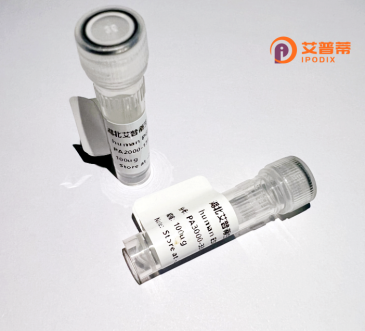
| 纯度 | >90%SDS-PAGE. |
| 种属 | Human |
| 靶点 | APG5L |
| Uniprot No | Q9H1Y0 |
| 内毒素 | < 0.01EU/μg |
| 表达宿主 | E.coli |
| 表达区间 | 1-275aa |
| 氨基酸序列 | MTDDKDVLRD VWFGRIPTCF TLYQDEITER EAEPYYLLLP RVSYLTLVTD KVKKHFQKVM RQEDISEIWF EYEGTPLKWH YPIGLLFDLL ASSSALPWNI TVHFKSFPEK DLLHCPSKDA IEAHFMSCMK EADALKHKSQ VINEMQKKDH KQLWMGLQND RFDQFWAINR KLMEYPAEEN GFRYIPFRIY QTTTERPFIQ KLFRPVAADG QLHTLGDLLK EVCPSAIDPE DGEKKNQVMI HGIEPMLETP LQWLSEHLSY PDNFLHISII PQPTD |
| 分子量 | 32.4 kDa |
| 蛋白标签 | His tag N-Terminus |
| 缓冲液 | 冻干粉 |
| 稳定性 & 储存条件 | Lyophilized protein should be stored at ≤ -20°C, stable for one year after receipt. Reconstituted protein solution can be stored at 2-8°C for 2-7 days. Aliquots of reconstituted samples are stable at ≤ -20°C for 3 months. |
| 复溶 | Always centrifuge tubes before opening.Do not mix by vortex or pipetting. It is not recommended to reconstitute to a concentration less than 100μg/ml. Dissolve the lyophilized protein in distilled water. Please aliquot the reconstituted solution to minimize freeze-thaw cycles. |
以下是3篇关于重组人APG5L(ATG5)蛋白的参考文献及其摘要概括:
---
1. **文献名称**: *Autophagy: Molecular Machinery for Self-Eating*
**作者**: Mizushima, N., et al. (2002)
**摘要**: 本文系统综述了自噬相关蛋白(包括ATG5)的分子机制,重点描述了重组人ATG5蛋白在自噬体形成中的关键作用,及其与ATG12结合形成泛素样复合物的过程,为自噬调控机制研究奠定基础。
---
2. **文献名称**: *Structural Basis of ATG3 Recognition by the Autophagic Ubiquitin-like Protein ATG12*
**作者**: Kaiser, S.E., et al. (2011)
**摘要**: 通过体外重组表达人源ATG5-ATG12复合物,结合X射线晶体学研究,揭示了ATG12的C端如何与ATG3相互作用,阐明了自噬过程中LC3脂化机制的结构基础。
---
3. **文献名称**: *Regulation of Mammalian Autophagy by Class III PI3 Kinase Complexes*
**作者**: Funderburk, S.F., et al. (2010)
**摘要**: 研究利用重组人ATG5蛋白进行功能缺失实验,证明其在Beclin-1调控的PI3K复合物中的重要性,揭示了ATG5通过参与自噬体膜形成影响肿瘤抑制的分子路径。
---
注:APG5L即ATG5.为自噬核心蛋白,以上文献主要涉及机制、结构及功能研究;如需具体实验类文献(如重组表达方法),建议补充筛选范围。
**Background of Recombinant Human APG5L (ATG5) Protein**
Recombinant human APG5L (autophagy-related 5-like), also known as ATG5. is a key protein involved in autophagy, a conserved cellular degradation process critical for maintaining homeostasis, eliminating pathogens, and surviving stress. ATG5 functions as part of the ubiquitin-like conjugation system, where it covalently binds to ATG12. forming a complex essential for autophagosome formation. This complex recruits ATG16L1 to facilitate membrane elongation and closure during autophagy.
Structurally, ATG5 contains a conserved N-terminal domain required for interactions with ATG12 and a C-terminal region critical for autophagosome maturation. Its role extends beyond autophagy, influencing apoptosis, innate immunity, and cellular differentiation. Dysregulation of ATG5 is linked to diseases such as cancer, neurodegenerative disorders (e.g., Parkinson’s), and infectious diseases.
Recombinant ATG5 protein is typically produced using bacterial or eukaryotic expression systems, enabling studies on its molecular interactions, enzymatic activity, and regulatory mechanisms. It serves as a vital tool for drug screening, pathway validation, and understanding disease mechanisms. Additionally, ATG5 knockout models highlight its indispensability in development and survival, underscoring its therapeutic potential. Research continues to explore its dual roles in pro-survival and pro-death pathways, making it a focal point for targeting autophagy-related pathologies.
×